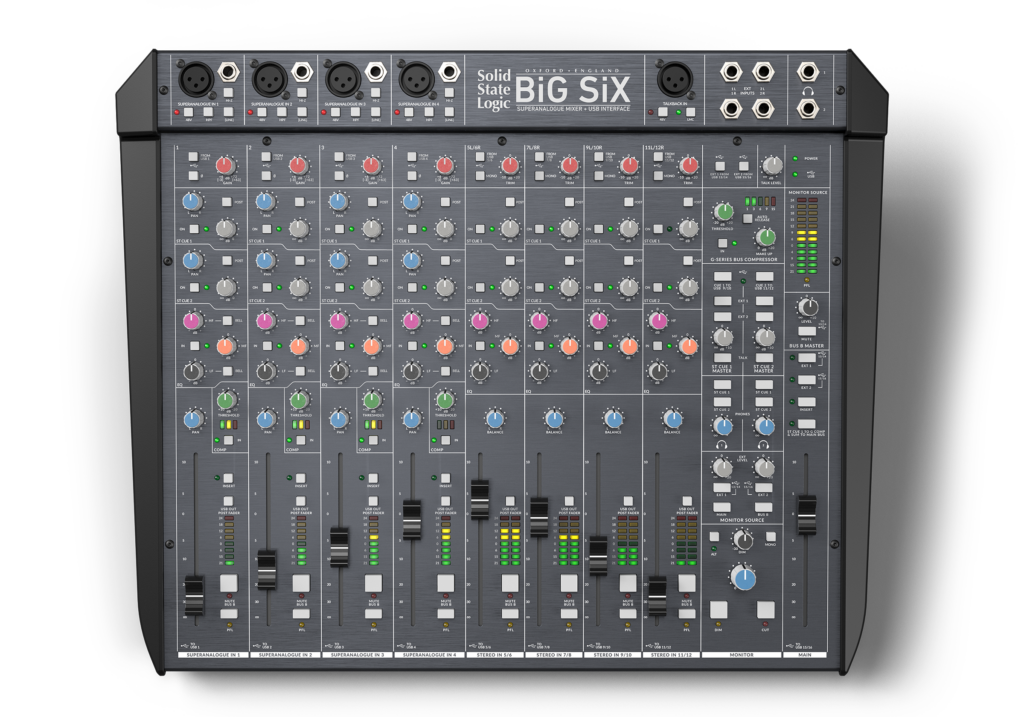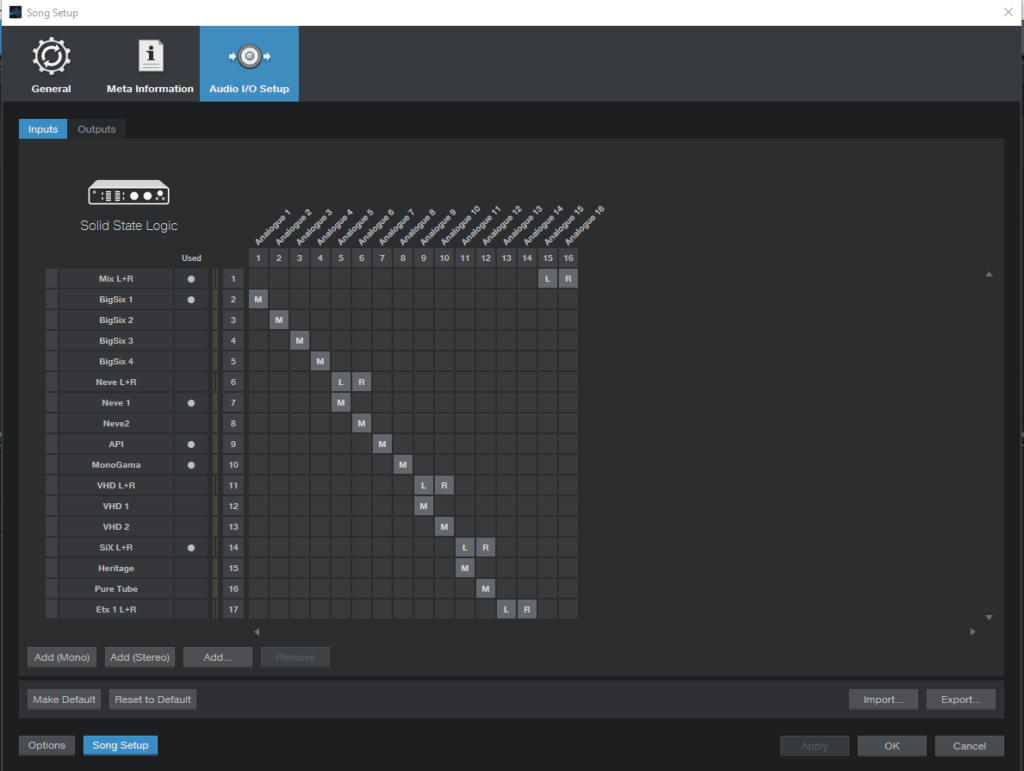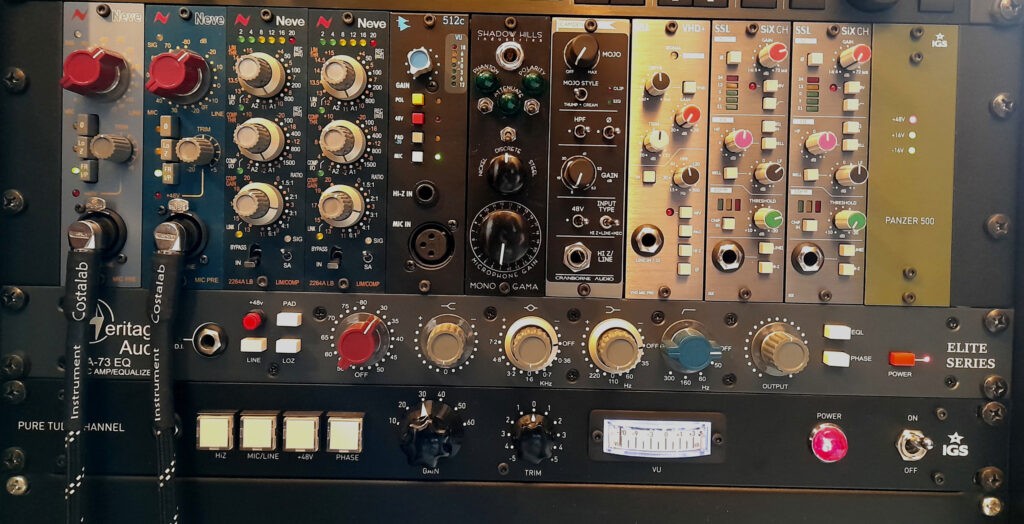Recording, Mixing and Mastering
Published on 28/02/2022

We have already talked about the Solid State Logic BiG SiX in one of the previous posts. In that post we have been focusing about the configuration possibility of the machine. A few weeks ago we received the console to test. Let’s see how the BiG SiX performed (spoiler: we liked it very much!)
We had already spent several months with the original SSL SiX as well as the SiX Channel. We are, then, familiar with the fundamental concepts used to develop this new console.

The BiG SiX has been designed taking into account the requests coming from the SiX owners. Due to this we can find:
As per the SiX smaller console, the used technology is the well known and patented Superanalogue with state of the art specs in terms of frequency response, speed and dynamic.
The headroom (guaranteed by the on board installed A/D and D/A converters) is 24dBu.
All the connections are fully balanced. The microphones, the headphones and the Ext1 and Ext2 inputs are accessible from the top panel. All the other connections are on the back of the unit. Those are TRS Jacks (6,3mm) available in a practical and well labeled patch bay.
The power supply is separate from the console and seems sturdy enough to give us several years of continuous utilization.
The metering is realized with several multicolored LED stripes which give a good understanding of the actual situation for both levels and compression ratios. All functions are controlled by specific switches often accompanied by LED to check the activation status.
The equalizersare of the three bands category. In the mono channels the High and Low bands can be switched between Shelf or Bell. This option is not available on stereo channels.
The four mono VCA compressors assignable on the mono channels have the threshold control only. Attack time is fixed while release time is adaptive (based on the input signal) and the gain make up is automatic.
The four stereo channels can be used in dual mono. This option is useful to connect further mic preamps to extend the number of input channels.
On the Master Bus is available the G-Series Bus Compressor. It can be controlled with Thresholdand Gain Make Up knobs. The release time has two options. One of those is the well known and widely used Auto Release.
The USB outputs are pre-assigned to the twelve mixer channels (from one to twelve) and to the stereo Ext inputs (Ext1 ed Ext2). With the press of a button (for each channel) the BiG SiX can be configured as a mixing console for DAW tracks.
Following the same principle, the 16 interface inputs are connected to the outputs of the channels, to the B Bus and to the Main Bus. In this way the channels can also be used as hardware plugins if needed while the whole mix (processed by the Master Bus and the Master Insert) can be sent to a stereo track of the DAW to print it. Muted tracks have their signals sent to the B Bus (and the related USB inputs).
In our studio, for tracking, we connected eight more mic preamps to the stereo channels. The DAW inputs (Studio One in our case) have been configured as per the following figure:

Inputs 15 and 16, configured as a stereo couple, are used to receive the console’s Master Bus.
The inputs 5/6, 7/8, 9/10 and 11/12 can be, with this set up, used either as a stereo couple or with mono signals. In this case the Mono button comes handy to ensure proper monitoring by the performer.
The Ext2 stereo output from the console gets into the 15 and 16 inputs of the interface.
In this way listening from the DAWs master bus all the BiG SiX functions are excluded by the signal path to allow the Mix in The Box when needed.

On the mono channels we have inserted four channel strips (eq+comp) to increase the versatility of the processing.
The same has been done for the Master Bus where we have an SSL Fusion with another Bus Compressor on its own insert.
With this configuration we are able to use the “St Cue 1 to G Comp & sum to main bus” option. This (apart from the tricky name) allows the Stereo Cue 1 to feed the G Series Bus Compressor and sum the output to the main mix.
This implements the parallel compression which is widely used, for instance, in mixing the drum sets.
This is the reason why we have the second compressor in the Fusion’s insert loop. This unit is used to glue the rest of the mix.
The Stereo Cue 2 has been used to feed and external hardware reverb. It is also possible to redirect the CUE outputs to the DAW (reducing the available channel count for the mix) to use plugins for delay, modulations, reverbs and any other desired processing.

The audio interface works at 24bit with sampling frequency up to 96KHz. The driver is extremely stable and the latency very low (round trip less than 5msec with a 64 samples buffer).
As we were saying before, the BiG SiX can be used as a simple audio interface with a monitor controller. We understand this can be thought as nonsense but there are cases in which this mixing option is used (from rough mix to recallable sets) and, if this is the case, the BiG SiX is there.
This is the natural way of using the console. Analog mixing for digital recording. Once the DAW and the external hardware are configured, the BiG SiX becomes the analog centerpiece of the studio. For those who already have an audio interface there is still the full analog option with a machine with the wonderful Superanalogue specs.
We found ourselves quite often using channel one for the main vocal, channel two for bass, three for kick, four for snare. Tracks five and six for the rest of the drums and the three remaining stereo channels for, respectively, guitars, keyboards and choirs. Different configurations are obviously possible. The main benefit (sound apart) of working with a real console is the feeling with real knobs and buttons and the attention paid mainly to the audio and listening part instead of the visual impact given by the waveforms on the screen.
The quite good audio spec allows also to think of using the BiG SiX for mastering given the home or project studio scenario.
In this case one could use the four stereo channels for stems previously processed by plugins in the DAW (plus a final touch with the onboard analog equalizers) and activate the Master Bus insert to give the right colour or to use proper hardware processors.
Let’s spend a few words about the sound of the console to close the post. In one word we could say that the SSL BiG SiX sound is alive! It is musical and every single knob or button has its sense in the realization of the sonic message.
The equalizers, even if the control set is limited, are extremely effective.
The mono compressors seem to be more gentle if compared with those on the smaller SiX.
The G Series Bus Compressor is simple but awesome.
The transient response of the console is guaranteed by the ample bandwidth which goes up to 80KHz (so, a lot more than necessary).
Very good and for sure at a professional level is the central section dedicated to monitoring. The functions are all there. From the possibility to switch between two sets of monitors to the Talk Back passing through Mono, Dim (tunable) and Cut (mute). A monitor matrix allows selecting from Cue Bus, Master Bus or Ext1 and Ext2 inputs.
Two are the headphone outputs. Those are of higher quality and capable of driving high impedance units.
The sound is open and ready for any other further processing. As stated before, the wide possibilities offered by the onboard processors and routings can be expanded using external tools to give, if needed, all the required color to complement the extremely clean BiG SiX.
As the majority of the analog consoles the recall is manual. In this case it could be useful to print the single channel outputs. In this way the mix recall (including fader and knobs movements) would be made easier. It is not a full recall but, for sure, it would help.
If you like the analog sound and the recall is not a must for your workflow, the BiG SiX has to find a place as the center of your home or project studio.
Join us today and get 5% off your next order!

Empty cart